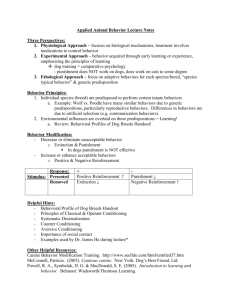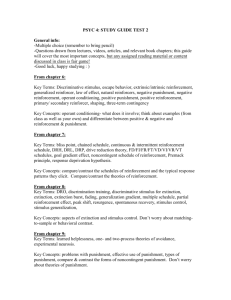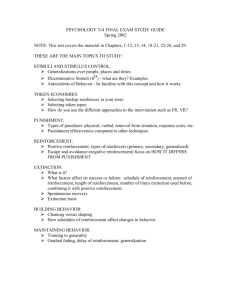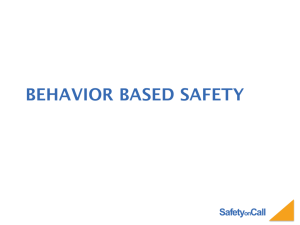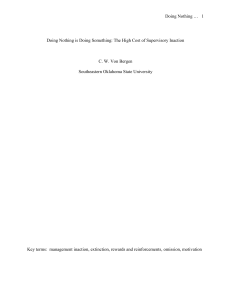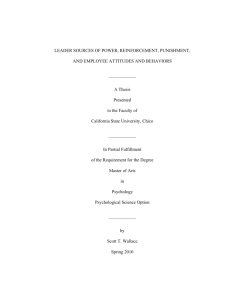ABSTRACT, Behavioral Approaches to
advertisement
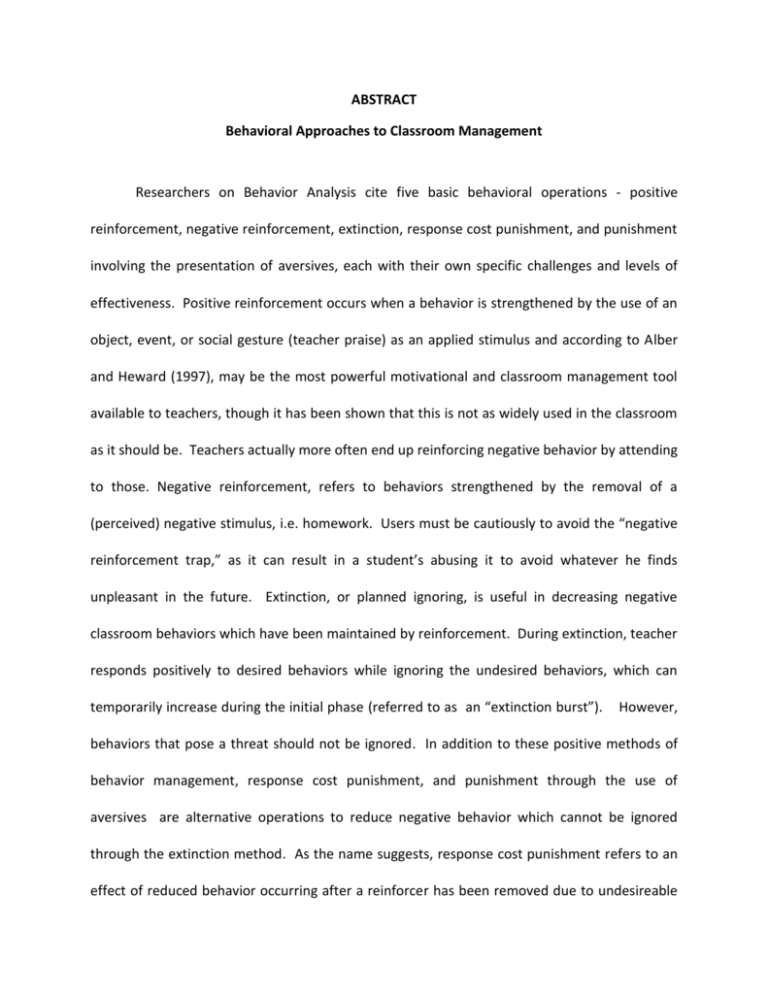
ABSTRACT Behavioral Approaches to Classroom Management Researchers on Behavior Analysis cite five basic behavioral operations - positive reinforcement, negative reinforcement, extinction, response cost punishment, and punishment involving the presentation of aversives, each with their own specific challenges and levels of effectiveness. Positive reinforcement occurs when a behavior is strengthened by the use of an object, event, or social gesture (teacher praise) as an applied stimulus and according to Alber and Heward (1997), may be the most powerful motivational and classroom management tool available to teachers, though it has been shown that this is not as widely used in the classroom as it should be. Teachers actually more often end up reinforcing negative behavior by attending to those. Negative reinforcement, refers to behaviors strengthened by the removal of a (perceived) negative stimulus, i.e. homework. Users must be cautiously to avoid the “negative reinforcement trap,” as it can result in a student’s abusing it to avoid whatever he finds unpleasant in the future. Extinction, or planned ignoring, is useful in decreasing negative classroom behaviors which have been maintained by reinforcement. During extinction, teacher responds positively to desired behaviors while ignoring the undesired behaviors, which can temporarily increase during the initial phase (referred to as an “extinction burst”). However, behaviors that pose a threat should not be ignored. In addition to these positive methods of behavior management, response cost punishment, and punishment through the use of aversives are alternative operations to reduce negative behavior which cannot be ignored through the extinction method. As the name suggests, response cost punishment refers to an effect of reduced behavior occurring after a reinforcer has been removed due to undesireable behavior, such as costing the student loss of recess time. Teachers can use this method to address problems immediately, but must use it cautiously so as not to create the result of a student who has nothing left to lose. Opportunities for positives must outweigh those for removal, particularly in students with high levels of disruptive behavior. The other type of punishment involves using aversives, and should always be considered as a last resort for students who have severe behavior problems and do not respond appropriately to any of the previous methods. An aversive can range from stimulus that cause physical pain or discomfort to those which evoke only emotional discomfort, like scolding. Though professional organizations such as National Association of School Psychologists, the Association for Persons with Severe Handicaps, and the Council for Excetional Children are calling for the discontinuation or severely restricted use of this model which is also considered to lack longterm positive effects in altering a child’s behavior. In fact, Troutman (2003) suggests that what students learn most from [this model] is “not to perform the behavior when the person who applied the punishment is present.” Researchers used a multiple of Applied Behavior Analysis designs in order to test their theories regarding the effectiveness of the above mentioned operations. The ABAB, or Reversal Design model measured behavior at a baseline phase, intervention phase, return to baseline phase, and return to intervention phase to determine a functional relationship between the behavior (of a 2nd grade ADHD student) and the intervention-assignment choice (Powell and Nelson, 1997). The Multiple Baseline Designs allowed for repeated demonstrations which can be used to study a single student in multiple settings, multiple students in the same setting, or a single student with multiple behaviors. In the study done by Hartley , Bray, and Kehle (1998), a functional relationship was determined to be present between the baseline data of three second grade students who were video taped raising their hands following cues to respond to teacher questioning, and the intervention, where they were shown an edited version of the same lesson which did not include the cueing system. Fabiano and Pelham (2003) used this model to evaluate effects of changes of a behavior management plan of a third grade, ADHD student across class periods. And finally, Magee, and Ellis (2000) used this model to study the functional relationship (of a student with multiple problematic behaviors) of baseline data and the extinction method which resulted in successful reduction of all four problematic behaviors. Other design models include the Changing Criterion Design, which Deitz and Repp (1973) used to successfully decrease inappropriate talking in a high school classroom, and the Multielement or Alternating Treatment Design which McQuillan, DuPaul, Shapiro, and Cole (1996) used to study the relationship of baseline data to two different interventions of three adolescent students with behavior disorders during mathematics performance and time on task . Criticism of behavior management studies suggest that we don’t know all there is to know about behavior management. And, that there are three very big concerns: researchers failure to produce effects which generalize to other settings, times and responses; the concept of coercion or bribery in which some believe teachers are too controlling in their attempt to make a student behave the way he/she desires; and ethical dilemmas where there is potential for misuse. Recent trends in behavior indicated that researchers are now more interested in how research translates to practice which can be feasibly implemented by teachers, parents, and psychologists. Of these new trends is the concept of performing a Functional Behavior Assessment (FBA) in an attempt to determine the function of a student’s problematic behavior. This process, though long and involved, and usually requiring additional staff assistance, may reveal if the root of a student’s misbehavior is due to frustration, boredom, attention seeking, or avoidance of unpleasant activities. One the function of a behavior has been determined, it is far easier to apply appropriate interventions or negotiate alternative tasks to satisfy that function while avoiding problematic behavior. Finally, though not wide-spread, a school-wide movement toward prevention which can be applied to all students, and requires little funding or effort. Walker (2003-2004) states that the school-wide behavior management prevention model will improve the behavior of most students, have great effects on students who are at the margins of misbehaving, and provide a foundation of good behavior management for serious troublemakers who will need the support of a good school-wide system for interventions to have maximum effect. Effective classroom management, despite its controversies regarding punishment and rewards vs intrinsic motivation, requires proper training in order to be used skillfully.
